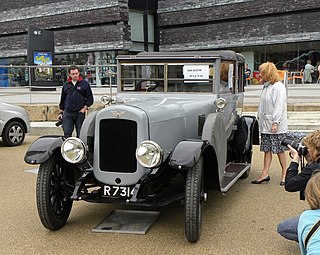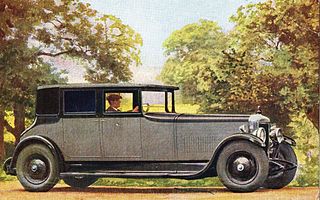Related Research Articles

The Austin Sixteen Light Six is a British car that was made by Austin from 1927. Announced in October 1927, the first deliveries were planned for March 1928.
The Lanchester Motor Company Limited was a British car manufacturer in active trade between 1899 and 1955. Though the Lanchester Motor Company Limited is still registered as an active company and accounts are filed each year, the marque has been dormant since. As of 2014 it is marked as "non-trading".

The Bentley 6½ Litre and the high-performance Bentley Speed Six were rolling chassis produced by Bentley from 1926 to 1930. The Speed Six, introduced in 1928, became the most successful racing Bentley. Two Bentley Speed Sixes became known as the Blue Train Bentleys after their owner Woolf Barnato raced the Blue Train in 1930.
The Rover 8 was a small single-cylinder 8 hp 1327 cc car made by the British Rover car company. It was Rover's first production car. It was remarkable for being supported by a backbone chassis rather than a conventional ladder frame. The first model was manufactured from 1904 to 1912. A Daimler-Knight sleeve valve engine option was available on the original model in 1911 and 1912.

The Rover 10 was a small family car from the British Rover car company produced between 1927 and 1947.

The Wolseley Hornet is a six-cylinder twelve fiscal horsepower lightweight automobile which was offered as a saloon car, coupé and open two-seater as well as the usual rolling chassis for bespoke coachwork. Produced by Wolseley Motors Limited from 1930 until 1936, the Hornet was unveiled to the public at the end of April 1930. Wolseley had been bought from the receivers by William Morris in 1927.

The Rover Meteor was a short-lived 2½-litre or 2-litre medium-sized car made by The Rover Company Limited of Meteor Works Coventry. The new 2½-litre model was announced in mid-February 1930 to supplement Rover's Light Twenty which used the same engine and essentially the same chassis.

The Rover Light Six was a narrower lightweight short wheelbase variant of their Two-litre sports saloon produced from 1929 to 1930 by the Rover Company of Coventry. The following season it was sold with a 2½-litre 20 hp engine under the name Rover Light Twenty.

The Rover 12 was a name given to several medium-sized family cars from the British Rover car company between 1905 and 1948.

The Vauxhall 30–98 is a car manufactured by Vauxhall at Luton, Bedfordshire from 1913 to 1927. In its day, its best-known configuration was the Vauxhall Velox standard 4-seater with open tourer body. Vauxhall's own description was the 30–98 hp Vauxhall-Velox sporting car. The 30–98 is also known to enthusiasts by Vauxhall's chassis code E.

Austin Twenty is a large car introduced by Austin after the end of the First World War in April 1919, and continued in production until 1930. After the Austin 20/6 model was introduced in 1927, the first model was referred to as the Austin 20/4.
The Rover 16/50 and Rover 16 are mid-sized cars which were produced by Rover from 1926 to 1929 and non-continuously from 1936 to 1947 respectively.

The Daimler Double-Six sleeve-valve V12 was a piston engine manufactured by The Daimler Company Limited of Coventry, England between 1926 and 1938. It was offered in four different sizes for their flagship cars.
The Rover Fourteen was a medium-sized family car and variants produced by the British Rover car company between 1924 and 1948. Civilian automobile production was interrupted in 1940 because of the war, but when the war ended in 1945, the Rover 14 returned to the market and remained available until replaced by the Rover 75 at the beginning of 1948.

The Vauxhall 23-60 is a four or five-seater touring car manufactured by Vauxhall of Luton that was announced in July 1922. The 23-60's standard tourer Kington body was described as "preserving that greyhound look so characteristic of the Vauxhall car". It shared many parts with Vauxhall's much more powerful 30-98.

The Vauxhall 20-60 is a four or five-seater saloon, limousine, tourer or coupé-cabriolet manufactured by Vauxhall of Luton. It was announced on 28 September 1927 with a six-cylinder engine and a four-speed gearbox. A cautious move downmarket. "The first time any six-cylinder Vauxhall has been sold under £1000!" "British & Vauxhall". The initial 2.7-litre engine was enlarged to 3-litres after twelve months.

The "bullnose" Morris Oxford is a series of motor car models produced by British manufacturer Morris from 1913 to 1926. It was named by W R Morris after the city in which he grew up and which his cars were to industrialise.

The Rover 20 was a new medium sized car announced by Rover in June 1907. It was a production version of the car which won the Isle of Man Tourist Trophy Race in 1906. However artillery wood wheels were fitted instead of the wire wheels used in the race and the longer wheelbase allowed the engine to be kept out of the passenger area. The prototype's engine came back beneath the petrol tank.

Their new Daimler 22 horsepower full-size luxury car was first displayed by Daimler in April 1902 at The Automobile Club’s Exhibition in London's Agricultural Hall. Daimler had elected to drop their multiple old low powered designs and restrict themselves to this 22 horsepower and a pair of 9 or 12 horsepower cars to the same design as the 22 but more lightly constructed. The King’s not quite finished new Daimler 22 was reported to be the chief attraction of the show.

The Vauxhall Big 6 is a name given to a series of automobiles which was produced by Vauxhall in England from 1934 to 1940. Rolling chassis were also bodied in Australia.
References
- 1 2 3 4 5 6 7 "Motor-Cars For 1928". The Times. No. 44678. 5 September 1927. p. 7.
- 1 2 3 4 5 6 7 8 9 10 11 12 13 14 15 16 17 "Cars Of To-Day". The Times. No. 44780. 3 January 1928. p. 17.
- ↑ Baldwin, N. (1994). A-Z of Cars of the 1920s. Devon, UK: Bay View Books. ISBN 1-870979-53-2.
- ↑ "Rover Cars". The Times. No. 45423. 29 January 1930. p. 19.
- 1 2 Culshaw; Horrobin (1974). Complete Catalogue of British Cars. London: Macmillan. ISBN 0-333-16689-2.
- ↑ Hough and Frostick (1966). Rover Memories. London: George Allen and Unwin.
- 1 2 "The Motor Show". The Times. No. 44715. 18 October 1927. p. 10.